East Anglian Railway Museum facts for kids
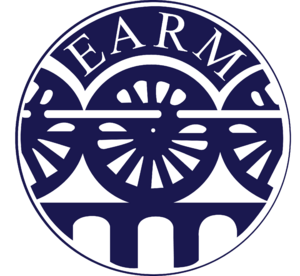 |
|
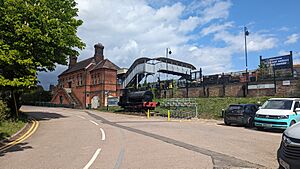
Entrance to the East Anglian Railway Museum
|
|
| Lua error in Module:Location_map at line 420: attempt to index field 'wikibase' (a nil value). | |
| Former name | Stour Valley Railway Preservation Society |
|---|---|
| Established | 1968 |
| Location | Chappel & Wakes Colne railway station, Essex, England |
| Type | Industrial railway museum |
| Collection size | 10 Locomotives, numerous other vehicles |
The East Anglian Railway Museum is a fun and historic place located at the Chappel and Wakes Colne railway station in Essex, England. It sits on an old railway line that once ran from Marks Tey to Sudbury. Today, you can still see modern trains on the Sudbury Branch Line run by Abellio Greater Anglia.
The museum is home to a large collection of trains, including steam locomotives and other railway vehicles called "rolling stock." Some of these are beautifully restored and working. You can even see real-life versions of Thomas the Tank Engine, Percy, and Toby!
On special event days, you can take a ride on a steam or diesel train along a short track. The museum also hosts popular beer festivals every year in the winter and summer.
Contents
How the Museum Began
The museum started as the Stour Valley Railway Preservation Society on September 24, 1968. A group of people wanted to save the history of the local railways. In December 1969, they rented the old goods yard and buildings at Chappel & Wakes Colne Station from British Rail. Just three months later, they held their first public "steam day" for visitors.
The team worked hard to restore the station buildings and the goods shed. The goods shed became a workshop where they could repair and restore the old trains.
In 1986, the society changed its name to The East Anglian Railway Museum. This new name showed that they wanted to preserve the railway history of the whole East Anglia region, not just run trains. The museum became a registered charity in 1991.
The Museum's Train Collection
The museum has many different types of trains and railway vehicles. Here's a look at some of them.
Vehicle Status Guide:
- Operational: The vehicle is in working order and can be used.
- Static Display: The vehicle is on show for people to look at but does not run.
- Under Overhaul/Restoration: The vehicle is being repaired or rebuilt.
Steam Locomotives
These are engines powered by steam. The museum has several, from small industrial engines to larger ones that ran on main lines.
| Type | Number | Name | Livery (Paint Color) | Year Built | Works No. | Status | Notes | Photo |
|---|---|---|---|---|---|---|---|---|
| Andrew Barclay 0-4-0ST | 11 | Storefield (Name not carried) | Lined Brown | 1905 | 1047 | Operational | This engine was rebuilt and returned to service in 1999. It was fixed up again in 2015. | 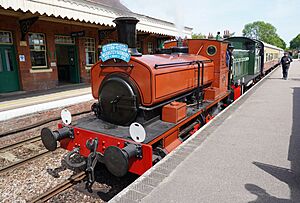 |
| Bagnall 0-4-0 ST | (Runs as No.6 for DOWT) | Jubilee
(Percy) |
Bright Green | 1936 | 2542 | Operational | This engine was changed to look like Percy the Small Engine from the Thomas the Tank Engine stories. | 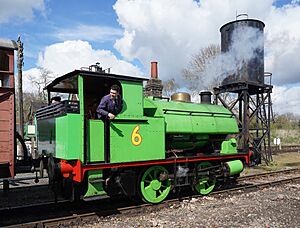 |
| RSH 0-6-0ST | 54 (Runs as No.1 for DOWT) | (Thomas) | Sky Blue | 1941 | 7031 | Operational | This engine was turned into a version of Thomas the Tank Engine and started running in 2008. It was overhauled in 2017. | 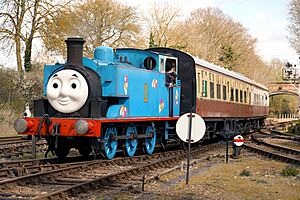 |
| Peckett and Sons 0-4-0ST | Jeffrey | Black | 1943 | 2039 | Static Display | You can see this engine on display outside the museum entrance. |  |
|
| W.G. Bagnall 0-6-0ST | 3 | Lamport | Colchester
Crimson |
1942 | 2670 | Under Overhaul | This locomotive is being fixed up. It needs new boiler tubes and a new firebox to work again. | 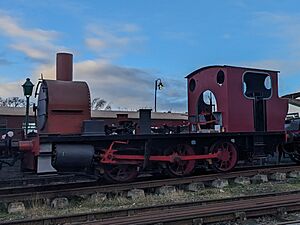 |
| London North Eastern Railway class N7 0-6-2T | 9621 (BR No.69621) | A J Hill | LNER Post-war Unlined Black | 1924 | Under Overhaul | This engine's safety certificate for its boiler expired in 2015. It is currently being repaired in Liverpool. | 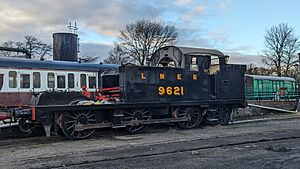 |
Diesel Locomotives
These engines are powered by diesel fuel, not steam. They were often used for shunting (moving wagons around).
| Type | Number | Name | Livery | Year Built | Works No. | Status | Notes | Photo |
|---|---|---|---|---|---|---|---|---|
| Drewry 0-4-0 | WD72229. | - | WD Bronze Green | 1944 | - | Operational | Returned from being fixed up in 2024. It sometimes pulls passenger trains. |  |
| Andrew Barclay 0-4-0 | John Peel | Lined Blue | 333 | Operational | This engine works but is only used sometimes because it doesn't have an electric start. |  |
||
| British Rail Class 04 0-6-0DM | D2279 | - | BR Green With Wasp Stripes | - | Operational | This is the main shunting engine at the museum. It's used for driver experiences and sometimes pulls passenger trains. | 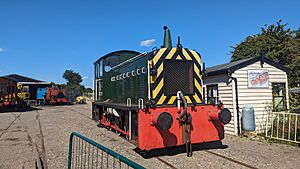 |
|
| John Fowler 0-4-0DH | 7 | (Toby) | Brown | 4220039 | Out of Service | This engine was changed to look like Toby the Tram Engine for special "Day Out with Thomas" events. | 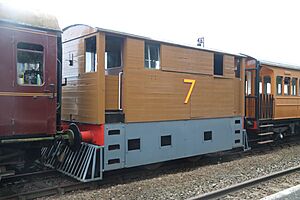 |
|
| Simplex 0-4-0 | 2029 | Blue | Under Restoration | This is a long-term restoration project. |
Multiple Units and Railbuses
These are trains where the engine and passenger carriages are combined into one unit. Many of these used to run on local railway lines.
| Class | Vehicle Type | Number | Livery | Year Built | Status | Notes | Photo |
|---|---|---|---|---|---|---|---|
| Waggon und Maschinenbau Railbus | 4w-DM | E79963 | BR Green | 1958 | Operational | This railbus was bought in 2012 and fully restored by 2021. It used to run on the local Sudbury Branch line. | 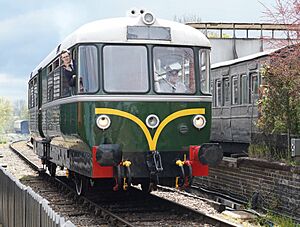 |
| BR Class 101 DMU | DMBS | E51213 | BR Blue/Grey | 1958 | Operational | This train unit also used to run on the Sudbury Branch line. | 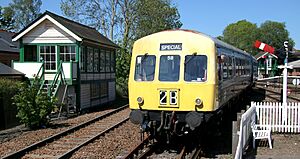 |
| BR Class 101 DMU | DTCL | E56358 | BR Blue/Grey | 1959 | Operational | This carriage was repainted in August 2024. It also ran on the local Sudbury Branch. |  |
| BR Class 309 EMU | BTDC | 75965
(309624) |
Network SouthEast | 1962 | Static Display | Arrived in April 2024 and was cosmetically restored by February 2025. It has the unofficial nickname 'Bessie' in the cab. | 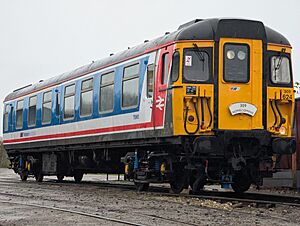 |
| BR Class 309 EMU | MBS | 977966
(309624) |
TCS Blue/White | 1962 | Undergoing Overhaul | Arrived in April 2024 and is now being repaired to protect it from the weather. It carries the name 'New Dalby'. | 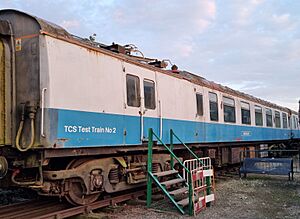 |
| BR Class 317 EMU | DTSO | 77092
(317345) |
Network SouthEast | 1981 | Static Display | Donated to the museum in 2021. It was restored and wrapped in the Network SouthEast design in 2022. It is used as Santa's grotto at Christmas. | 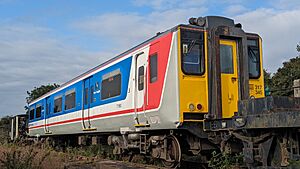 |
Passenger Carriages
The museum has a collection of passenger carriages, some of which are very old.
| Type | Number | Livery | Year Built | Status | Notes |
|---|---|---|---|---|---|
| NLR Birdcage Brake | 70 | Teak | 1872 | Static Display | A special carriage body that is cut away so you can see inside. It is now in the new exhibition shed. |
| GER 6-Wheel | 247 | GER Crimson | 1888 | Grounded Body | This carriage body is used as indoor seating for the museum's pub. |
| GER Brake Third | 2155 | Unrestored | 1921 | Under Conservation | A very rare example of this type of carriage. It is stored indoors to protect it. |
| LNER TTO | 23953 | LNER Green/Cream | 1936 | Out of Use | This was an exhibition coach. It is not currently in use. |
| BR Mark 1 TSO | E3779 | BR Maroon/Crimson Cream | 1953 | Static Display | This coach is used as indoor seating for the museum's café. |
| BR Mark 1 SK | E24959 | BR Maroon/Crimson Cream | 1956 | Operational | One of the main carriages used for passenger rides. |
| VDA (Underframe Only) | 210234 | Brown | 1978 | Out of Service | A replica of a tramway coach was built on this wagon frame. It is styled to look like Henrietta from the Thomas the Tank Engine stories. |
Freight Wagons and Other Vehicles
This is a collection of wagons used for carrying goods, and other vehicles used for railway work.
| Type | Number | Livery | Year Built | Status | Notes |
|---|---|---|---|---|---|
| GWR 4w Toad Brake | 17898 | GWR Grey | 1914 | Operational | This is the main brake van used on the museum's trains. It was donated by a longtime museum member. |
| Grafton Steam Crane | PO 762 | Green | 1914 | Static Display | A large crane powered by steam. |
| LMS 5-Plank | M405032 | BR Grey | 1936 | Operational | This wagon has been changed to have bench seats for giving rides. |
| SR Parcels and Miscellaneous Van | SR 1152 | SR Malachite Green | 1937 | Static Display | Used as a covered area during driver experiences and beer festivals. |
| BR 20T Brake | B951771 | BR Bauxite | 1952 | Operational | Restoration was finished in December 2024. It now has vacuum brakes. |
| Plasser & Theurer GPC72 12t Diesel Crane | DRP81521 | NR Yellow | 1980 | Operational | A modern crane used for engineering work around the museum. |
A Famous Concert
On June 13, 2009, the rock band Blur played a concert at the museum. This was a special event because it was the same place where they had their very first concert back in 1988.
Just like their first show, the band played to about 150 people inside a goods shed. This was the first show of their 2009 tour. Later that year, they played at the famous Glastonbury Festival and in Hyde Park.
In November 2009, a special plaque was put up at the museum to celebrate Blur and their first-ever live performance there.

